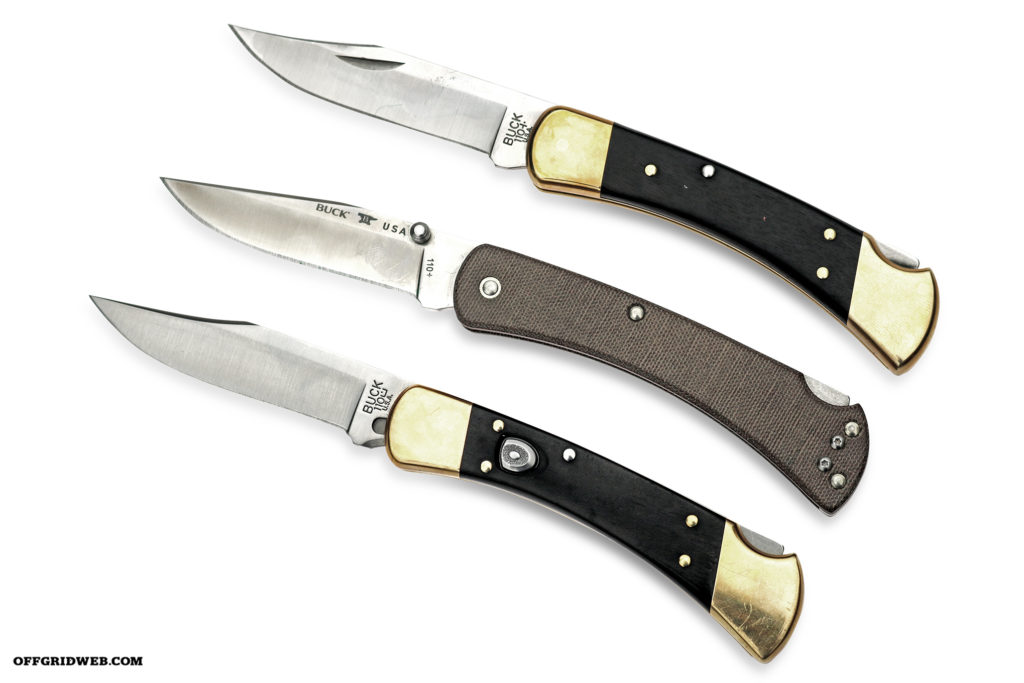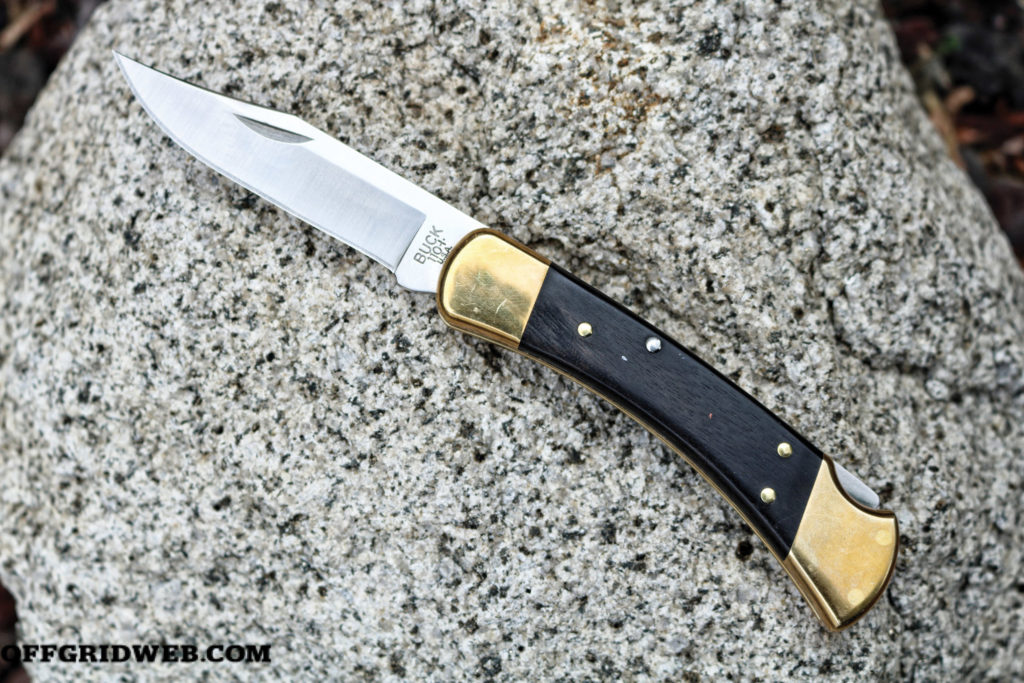RECOIL OFFGRID Preparation The Buck 110 Folder Review and History
In This Article
When we hear the term “survival knife,” we most often think of a large fixed blade of some type and not a folding pocket knife. Yet, the Buck 110 Folding Hunter may make you change that way of thinking.
The Buck 110 was a familiar sight for many years. Although it’s pocket-sized, it was mostly worn on the belt in a leather sheath secured with a single snap. Even those who know little about knives can recognize it immediately. It was worn by hunters, farmers, craftsmen, tradespeople, and anyone who had the need for a compact, sharp blade with a strong lock.
When a single model of any knife becomes synonymous with an entire company’s product line for decades, and inspires countless other designs (as well as blatant imitations), I’d say that qualifies as iconic.

The Buck 110 was designed in 1963 as a folding hunting knife. There had been a few knives of this type on the market, but none had really been successful, and Buck wasn’t exactly a new company at the time. They were well-known for their outdoor fixed-blade knives.

Above: The iconic Buck 110 Folding Hunter's overall look became synonymous with the company.
Although they got their start in 1902, the company didn’t incorporate until 1961. A mere two years later they decided to introduce the first folding knife that was nearly as strong as a fixed blade. Buck rolled out their Unconditional Lifetime Warranty at this time, which was also unheard of for a knife manufacturer. Lastly, they priced their knives anywhere from $12 to $20. This wasn’t exactly a king’s ransom in 1963, but the typical field knife retailed for around $5 at the time.
Credit must be given to the engineer who developed the locking bar on the Buck 110. It may look like a simple lock back, but it was designed to hold the blade in a solid position as well as release with minimal pressure applied to it.
The blade is a 3¾-inch clip point, similar to the classic Bowie knife but on a smaller scale. This is an interesting choice as it makes for a very narrow tapering point that’s critical for delicate cutting, and provides a slender tip for poking precise holes. The blade is robust enough to tackle anything from whittling stakes to skinning game.


Above: The Buck 110 Folding Hunter is a classic, rock- solid blade that has proven itself over the past 50-plus years.
As for steel, most Buck 110 Folding Hunters use 420C stainless steel. While some knife guys today may turn their noses up at this, 420C has proven to be very durable and corrosion-resistant. This has much to do with the exceptional heat treatment applied to the blades by the legendary Paul Bos, and a Rockwell hardness of 60. Still, if you want something more upscale, the Buck 110 can be had in S30V.
This classic design has two other elements that make it so iconic — namely, the distinctive front and rear brass bolsters and the ebony wood handles. When you see one, you know exactly what it is.
It generally takes two hands to open and close the knife, making it very safe and appropriate to give to a young person as a first-time knife. It uses a nail nick cut in the side of the blade, but some people install aftermarket thumb studs to modernize it. Back in the 1970s and 1980s it wasn’t uncommon for people to close the blade on a matchstick or toothpick in order to allow the knife to flick open more easily or open as it was drawn from a pocket.
Despite its initial price being on the high side, the Buck 110 Folding Hunter took off like wildfire. Remember, this was in 1964 — the concept of a CNC-milled titanium frame lock was unheard of. This high-tension lock back with a very low-pressure release mechanism seemed like magic.
It was hard not to spot the distinctive black leather sheath of the Buck 110 on the belts of men almost everywhere and from all walks of life. Despite the rest of the company’s offerings, when you saw a Buck 110 Folding Hunter — in the sheath or outside of it — it was referred to as a “Buck knife.”
As with any popular design, other manufacturers and custom knife makers drew inspiration from it. The classic look of the knife with front and rear bolsters and inset hardwood scales became very influential on the cutlery industry. The downside of that was that there were a lot of imitations from overseas, most notably India, Pakistan, and Taiwan. These knives were cheaper and used inferior materials based off of reverse-engineered knives.
To this day, the Buck 110 Folding Hunter has always been Buck’s number-one seller and there are tens of millions of them out there.
The knife has undergone some small changes over the years. These aren’t readily noticeable to the average user, and they’re typically an improvement. However, the U.S.-made leather sheath briefly went to nylon and eventually back to leather due to customer feedback.
Due to its relatively small size, the Buck 110 Folding Hunter fits that first commandment of survival knives: “Have a knife.” Whether it’s in its trusty leather belt sheath, a pocket, or a pouch on someone’s pack, it’s small enough to have with you whenever you need it.

We have left ours in a dedicated bag set up for hunting as a spare knife for years, and it has served well as a skinner, utility knife for cutting rope, and edged tool for other chores around camp. It may not be ideal for batonning firewood or quartering big game, but it can be done if it’s all you have available.
If there’s a drawback to the Buck 110 it’s that while the 420C blade is hard and tough, when the edge dulls it can be a bear to sharpen. We have had the best results with a Ken Onion Work Sharp sharpener set at a 20-degree angle and a medium-grit belt.
The Buck 110 not only influenced the look and feel of what was to become the modern lock-back folder from other makers but has inspired Buck’s own line of knives. Smaller versions, such as the Buck 112 with a 3-inch blade, have made the lineup as well as variants using different materials for handles and bolsters.
A fixed-blade version is available from Buck, but the company offers better fixed blades that can perform the same tasks. As fine of a knife as it is, this knife excels as a folder.
This fact wasn’t lost on Buck, either. It led to two lock-back descendants of the 110 Folding Hunter: the Buck 110 Auto and the Buck 110 Slim Pro.
Although I’m a self-proclaimed lifelong knife fanatic, part of me had felt that I had outgrown the Buck 110 Folding Hunter until 20 years ago when I saw an automatic conversion by the late Butch Valloton. Imagine the rock-solid lockup of a Buck 110 with an automatic opener — it seems like the perfect blend of old and new. It wouldn’t be long before Buck would make an automatic themselves based on this classic design.

Above: The opening button and lack of a nail nick are the only outward differences between the Buck 110 Auto and the Buck 110 folding knife that preceded it.
The first thing you notice is the distinctive silver-colored button on the handle, which compresses the spring and holds the blade closed when not in use. Press the button and the blade launches open from the side. You need to depress the lock bar to close it, but when it’s open there’s that rock-solid feeling of a fixed-blade knife in your hand once again. The only other things that set it apart are the hole in the blade where the auto mechanism keeps it closed, and the lack of the nail nick opener.
By this point you might be thinking that the Buck 110 has a lot of great attributes, but the design is a little dated. Perhaps you think it’s more suitable for your father or grandfather who likes brass bolsters, hardwood scales, a belt sheath, a nail nick opener, or even a steel like 420C.
 Above: The lighter weight of the 110 Slim Pro means that it can be carried via pocket clip as opposed to being worn in a belt sheath.
Above: The lighter weight of the 110 Slim Pro means that it can be carried via pocket clip as opposed to being worn in a belt sheath.
Buck recognized that too, and addressed it in their Buck 110 Slim Pro. They made the blade from S30V and added a thumb lug and a choice of either black G10 or tan or olive drab Micarta scales. Instead of a belt sheath, the knife is set up with a stainless reversible deep-carry pocket clip. They retained that clip-point blade and their lock-back system.
The end result is a stylish EDC pocket knife with modern materials based on one of the most proven folding blades ever made.
The Buck 110 Folding Hunter proved to the world that a safe and heavy-duty folding knife could be made well and priced reasonably. Tens of millions of these knives have rolled off their assembly line over the past 57 years, and it shows no sign of stopping. With a retail price of less than $50, this is an American-made iconic blade that everyone can easily afford to use as a daily work knife or emergency tool.
 STAY SAFE: Download a Free copy of the OFFGRID Outbreak Issue
STAY SAFE: Download a Free copy of the OFFGRID Outbreak Issue
No Comments